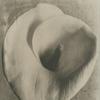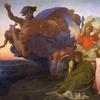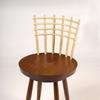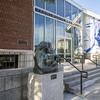Hollywood's Favorite Iranian Artist Leads Bonhams Sale
- LONDON, United Kingdom
- /
- October 01, 2014
The Modern and Contemporary Middle Eastern Art auction at Bonhams’ saleroom on New Bond Street, taking place on October 7, 2014, will catch the eye of at least two Oscar winners. The auction stars a photographic print by the celebrated Iranian director, Abbas Kiarostami, of whose work Martin Scorsese and Quentin Tarantino are vocal supporters, and a painting estimated at £70,000-100,000 by Ayman Baalbaki, the Lebanese painter, who has a life-story to match the most dramatic of those great directors’ narratives.
In contemporary cinema, endorsements don’t come much more resounding than the rapture with which Tarantino, Scorsese and the French New Wave director, Jean-Luc Godard, have spoken of the work of Abbas Kiarostami. Tarantino has raved on-camera about the virtues of Kiarostami’s 1994 feature Through the Olive Trees. Scorsese has asserted that ‘Kiarostami represents the highest level of artistry in the cinema.’ Godard went as far as saying that ‘film begins with D.W. Griffiths and ends with Abbas Kiarostami.’ Lofty praise indeed. Kiarostami is, perhaps, the celebrity filmmakers’ celebrity.
Though not recognised by the Academy itself, Kiarostami certainly deserves the praise of those who have received cinema’s most coveted award. He won the Palme d’Or at Cannes for Taste of Cherry in 1997, the Silver Lion at Venice in 1999, and was appointed to a Fellowship at the British Film Institute in 2005. He has shown great bravery, too, remaining in Iran after the Revolution while many other filmmakers fled.
The unique photographic print for sale at Bonhams, dated ‘2007’ and marked ‘1/1’, bears the scars of conflict despite depicting a subject which seems devoid of it. For it was in 1979, after the revolution, that Kiarostami was forced to abandon his filmmaking in favour of photography. ‘1979 was when I started taking photographs,’ he says. ‘We couldn’t make films and we were very depressed. I had this camera, a Yashica, and started shooting.’ With this camera in hand, he sought to reconnect with the country which lay beneath the political and social turbulence.
This desire is at the heart of A Window Through The Life. The bright serenity of the countryside is framed by a disintegrating concrete window, providing an exquisite example of Kiarostami’s motif of strong framing devices and visual minimalism. Into a dark and empty room comes a glimmer of light, a symbol for hope and rejuvenation.
Baalbaki’s L’Amorial, painted in 2011, provides his home-city of Beirut with a similar glint of optimism, finding new belief among the ruins. The painter’s life has been intertwined with the ongoing violence in Lebanon since the beginning. Born in 1975, the year of the outbreak of the Lebanese Civil War, his family was forced to flee the fighting in the Rass-el Dikweneh district when he was just a few months old. In 2006, the spectre of violence reared again when Israeli rockets destroyed his family home in Haret Hreik. The wounds of these experiences could not fail to haunt an artist’s work, and images of the scarred buildings and ruptured streets which have come to define many Middle Eastern cities dominate Baalbaki’s paintings.
The artist has found that the traces of a conflict are most enduringly preserved in the fragmentation and mutilation of a city’s architecture. But, as captured in the work on sale at Bonhams, the regeneration of the urban fabric can likewise be a symbol for the regeneration of a people and their culture. The work depicts Beirut’s Armonial building under construction, clad in green scaffolding, angled upwards as if viewed from the street to reinforce the scale of the new, ambitious project. Originally titled ‘Beirut Reconstructed,’ it is a metaphor of a slowly healing city, capturing the glow of promise to which Lebanon clings.
It was not so long ago that Kiarostami was denied the American Visa he required to attend the New York Film Festival. The sale of these two beautiful works, along with the hundreds of others in Bonhams’ auction, is testament to the strengthening relations between Middle Eastern artists and the international art world. At the Bonhams auction, these works can receive the international celebration they deserve.











100x100_c.jpg)
